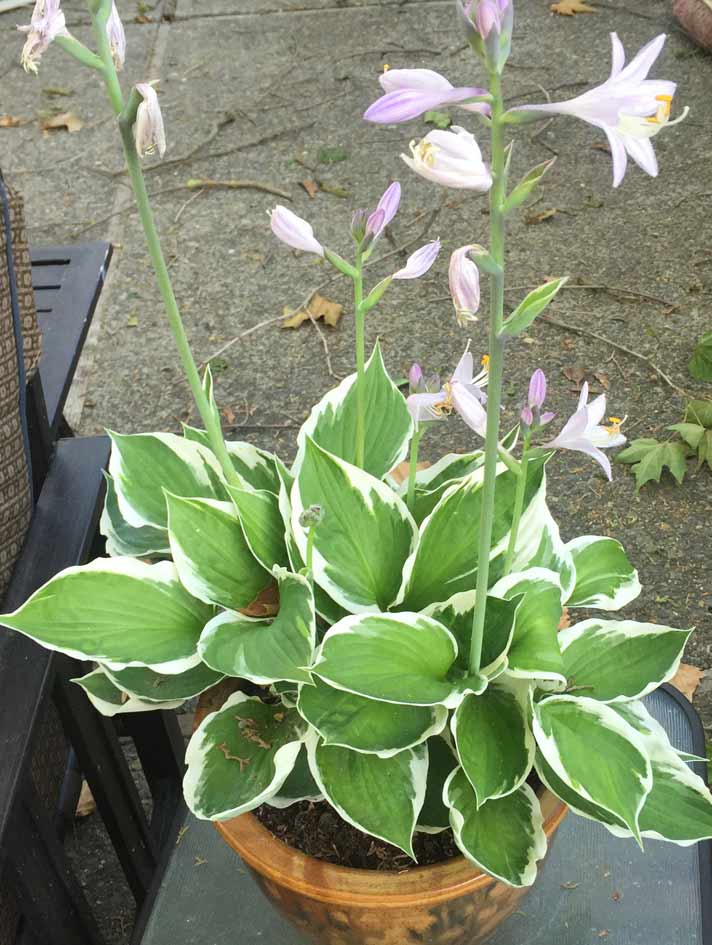The Literary Gardener – August 2017
“The first week of August hangs at the very top of the summer, the top of the live-long year, like the highest seat of a Ferris wheel when it pauses in its turning.” ~Natalie Babbitt, Tuck Everlasting, 1975
I love this image of August, the month when summer’s heat is at its zenith. At this time of year, my mood becomes a strange blend of wishfulness for the cooler days of fall and wistfulness for those early days in June when I fooled myself—again!—into thinking summer would last forever.
While I may be ambivalent about August, my hosta certainly are not. In fact, if these shade-loving plants could speak, they’d say “‘Hosta’ la vista, baby” to August and take a vacation until fall. That’s because hosta’s native lands are northeastern Asia where summer climes are not as intense as those in Southern Oregon. Alas, my hosta have their roots, literally, in east Medford, so it’s up to me to provide them with what they need to thrive despite occasional triple-digit temperatures.
I have three different varieties of hosta, of more than 3,000 registered with the American Hosta Society. When we bought our house, I inherited an H. fortunei with gleaming yellow foliage that turns greener in late summer. I’ve also added a potted H. ventricosa, a variegated species with dark green and cream-colored leaves and pronounced veining, as well as H. ‘Blue Angel’, a beautiful specimen plant with a blue sheen and slightly rippled, heart-shaped leaves. (I learned the leaves aren’t actually blue, though. They’re covered with a waxy substance that causes the leaves to appear blueish when the sun reflects off them.)
All hostas are rhizomatic perennials, so they return every spring like old friends when their furled leaf shoots emerge from the soil. It’s these shoots that prompted hostas to be reclassified from the lily family to the asparagus family. In fact, although hostas are poisonous to dogs, cats, and horses, the shoots (called urui) are considered a delicacy in Japan and prepared much like asparagus in a variety of gourmet dishes.
Hostas are named after the Austrian botanist Nicolas Thomas Host. They were imported from China to Europe in the mid-19th century, where they quickly became a popular garden plant, mostly for their attractive foliage but also for their delicate, lily-like flowers that bloom mid to late summer. Many of the original parent plants in the U.S. were imported from Japan in the 1870s.
Back when hostas were part of the lily family, the H. plantaginea species became known as the Assumption Lily among Catholics because the fragrant white flowers bloom in August. The plants were used during Feasts of the Assumption, observed on August 15 to celebrate the Virgin Mary’s bodily assumption into heaven. The white “lilies” of this plant species symbolize Mary’s purity, and the tall flower scape signifies her rise into paradise.
Another common name for hosta is plantain lily, from ‘planta’ or ‘sole of the foot,’ a reference to the broad leaves of many hosta species (although some leaves are lanceolate-shaped). The texture of hosta leaves are similar to other monocots, such as bananas and their cousins, plantains, but they are not otherwise related.
Probably due to the plant’s religious association, the Victorians attached the meaning of “devotion” to hosta. It was also called the “friendship plant” because it is easy to divide and share with others. Certainly no friend to hostas, though, are slugs and deer, which are immune to the plant’s toxins and seem to share with the Japanese their notion that young hosta shoots are tasty, indeed!
Hostas make a perfect addition to the shade garden, although lighter-colored varieties prefer more light. Plant them in deep, humus-rich soil with good drainage and provide plenty of moisture. Divide hostas now through September by using a spade or garden fork to carefully separate the clump into divisions with a few shoots coming out of the crown. Water the new divisions thoroughly before replanting and add a balanced fertilizer to help the plant rejuvenate from transplant shock.

 Rhonda Nowak is a teacher, writer and gardener who lives and works in the Rogue Valley. She has taught literature and language arts for 25 years, the last six at Rogue Community College. In addition to her column for the Jacksonville Review, she writes a weekly column and blog called the Literary Gardener for the Mail Tribune. She also writes articles for Southern Oregon Wine Scene magazine and is writer and editor of Ashland Living magazine. Email Rhonda at Rnowak39@gmail.com.
Read more on her blog at
Rhonda Nowak is a teacher, writer and gardener who lives and works in the Rogue Valley. She has taught literature and language arts for 25 years, the last six at Rogue Community College. In addition to her column for the Jacksonville Review, she writes a weekly column and blog called the Literary Gardener for the Mail Tribune. She also writes articles for Southern Oregon Wine Scene magazine and is writer and editor of Ashland Living magazine. Email Rhonda at Rnowak39@gmail.com.
Read more on her blog at